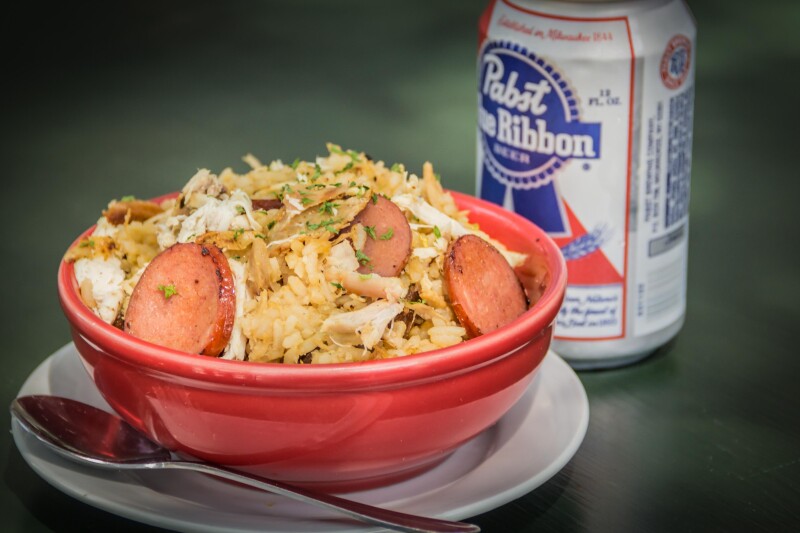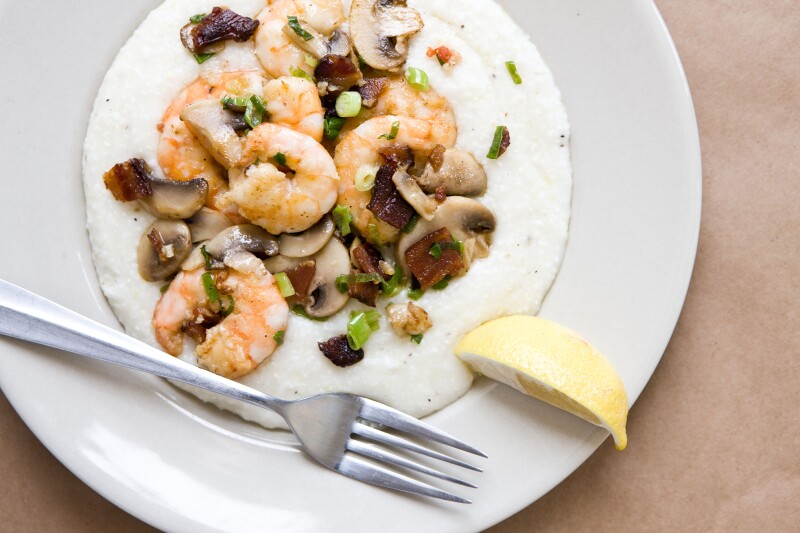Charleston’s culinary scene is known for its standout seafood and down-home country cooking, although today’s buzzed-about new restaurants are as likely to serve Indian fusion as shrimp and grits. That said, for all of the Lowcountry region’s history, architecture, and scenic beaches, it’s the area’s traditional cuisine that inevitably keeps visitors coming back.
The credit for many of Charleston’s unique dishes lies with the enslaved Africans who once worked the rice and cotton plantations here. Chances are good that you could trace the roots of even the most haute version of a regional specialty back to a simple meal cooked in a slave cabin or Gullah fishing shack in early Charleston. (Gullah refers to the African Americans who live along the coast of South Carolina and Georgia, a region known as the Lowcountry. The culture, cooking, and the creole language of the Gullah still strongly reflect the African origins of the original enslaved people from whom they have descended.)
The modern culinary touches are mere embellishments on traditional recipes created from the local ingredients at hand, each plate carrying forward the authentic flavors of the city. So get ready to dig in with this list of Charleston’s eight essential dishes, for which rich history adds gravity to every bite.

Just-caught royal red shrimp elevate the purloo at Husk.
Courtesy of Husk
1. Purloo
The planters who settled Charleston built their fortunes on the backs of slave labor, growing rice and cotton in the Lowcountry’s rich, wet soil. Dubbed “Carolina Gold,” the local long-grain rice cooks up fluffy and full. It was the starch component of nearly every Charleston dinner for centuries—the “linchpin of the antebellum cuisine of South Carolina,” according to entrepreneur Glenn Roberts, behind the artisan mill goods distributor Anson Mills—until instant rice like Uncle Ben’s nearly killed it off in the 1950s. Happily, Anson Mills brought it back to market in the 1990s through rigorous research, work with rice geneticists and other enthusiast-farmers, and testing with small crops. Today, Carolina Gold is once again a staple in Charleston kitchens.
The iconic grain is best enjoyed in a purloo dish, which Gullah Cuisine: By Land and by Sea author Charlotte Jenkins defines as “any time you add meat to rice and cook it all together in one pot.” But purloo isn’t simply proteins over a bland starch. As in the Mediterranean or African pilau, the rice is simmered in fish or chicken stock and seasoned heavily with onions, garlic, spices, and bacon or pork fat, before shrimp, oysters, or whatever meat is on hand is stirred into the rice.
The dish—sometimes spelled purlieu, pirlo, or perlieu—has only recently gained prominence in fine dining kitchens. Poogan’s Porch often serves a roasted duck “pirloo” with andouille sausage, while a variation of the dish rotates through the daily-changing menu at Husk. At the Grocery, Kevin Johnson keeps a table-size Lowcountry Seafood Pilau, a take on purloo, on his regular menu; it’s well worth the order.

Chicken bog tastes better than its name implies.
Photo by Acacia Falzone; courtesy of the Shelter
2. Chicken Bog
Chicken Bog may technically be a purloo, but this distinctly South Carolinian dish deserves its own place on the list. It’s made of chicken cooked down until it’s shredded and fine, and then stirred into rice with onions and peppers (and sausage, if the chef is feeling generous). The rice is intentionally left moist, making for a dish that’s rich and hearty and fills you up fast.
Chicken bog is a simple meal, typically eaten at home or family gatherings, although it’s on a few menus around town. The Shelter (across the bridge in Mount Pleasant) lets you sample a “bowl of bog” on its appetizer menu.

Hoppin’ John’s too tasty to only eat once a year.
Courtesy of Virginia’s on King
3. Hoppin’ John
Across the South, people traditionally eat Hoppin’ John and collard greens on New Year’s Day, but the dish’s roots are right in the rice plantations of Charleston. It’s a celebratory meal, where the usual rice and peas consumed by enslaved Africans was made hearty by the addition of pork. As with a purloo, it’s all cooked together in the same pot, as described in Sarah Rutledge’s 1847 cookbook, The Carolina Housewife. Today, it’s typically made with black-eyed peas and is hard to find on menus outside of the holiday season, although Virginia’s on King sometimes has it as a side item. In the PBS series Mind of a Chef, chef Sean Brock explains how a terrible bowl of Hoppin’ John in 1998 taught him the importance of the base ingredients—he uses Sea Island red peas and Carolina Gold rice, and that iteration sometimes appears on his menu at Husk.

Whether the menu reads Lowcountry Boil or Frogmore Stew, you’re sure to enjoy what arrives at the table.
Photo by Sarah Nielsen; courtesy of Fleet Landing
4. Frogmore Stew
On St. Helena Island, down the coast from Charleston, there’s a Gullah hamlet named Frogmore, whose name is now synonymous with a dish of shrimp, sausage, corn, and potatoes boiled together in spices and served on a communal table. Across South Carolina, you’ll often hear it called Beaufort Boil, while on menus in New York—or increasingly even in Charleston—it’s dubbed Lowcountry Boil. The number of different names for the same tasty dish may be due to cooks’ concerns that the “frog” in Frogmore may scare off potential customers. Even the old-school Bowens Island Restaurant adds an “aka Lowcountry Boil” disclaimer to Frogmore Stew on its menu. The fancy version at Fleet Landing, referred to as a Lowcountry Boil, is simmered in beer and enjoyed on the waterfront of Charleston Harbor.
For the best boil, gather a steam pot and the fixin’s—including Old Bay and a few pounds of shrimp, at Crosby’s—and serve it in the backyard or at a park picnic area over a newspaper-covered table. (Tip: Don’t forget the cocktail sauce.)
5. Steamed Oysters
Lowcountry oysters aren’t like others—or at least they didn’t used to be. Around Charleston, oysters grow in “clusters,” where as many as a dozen of them build their shells into and around each other. That makes them unwieldy to harvest one at a time, so whole clusters are tossed into the boat, rinsed at the dock, and then sold by the bushel. These typically get steamed in a pot or over a fire, in between a metal plate and a wet burlap sack.
Hence, the “oyster roast,” a wintertime tradition when Charlestonians gather to slurp oysters with saltines and cocktail sauce. It’s not uncommon for an individual to eat several dozen or more. But the international demand for raw, iced, $3-a-pop single oysters has arrived even here, and carefully cultivated local “singles” now rival West Coast and Massachusetts bivalves at upscale downtown oyster bars. But for pure authenticity, order a bucket at Bowens Island, 10 miles south of town, where the oysters are still steamed over an open fire and served, some still clustered, in a bucket.

The recipe for creamy she-crab soup was developed for a visit from President William Taft.
Courtesy of Revival
6. She-Crab Soup
Each spring, female blue crabs molt their shells and release their roe, soon to be the next generation. It’s a vulnerable time for the females; while their shells are soft, their meat is sweeter (Charleston’s soft-shell crabs, pre-soup, nearly made this list), and their eggs are a delicacy. She-crab soup takes a traditional crab bisque and livens it up with roe and sherry. Credit is given to chef William Deas, who embellished his crab soup when President William Howard Taft came to visit Charleston around 1910. His similar recipe for shrimp soup garnered inclusion in the 1930 cookbook, 200 Years of Charleston Cooking, and helped springboard Deas’s half-century career as a prominent Charleston chef.
Today, “she-crab” soup is a bit of a misnomer since it’s illegal to harvest crab roe in South Carolina—and blue crabs would be extinct if the actual demand were met. Yet she-crab soup is on hundreds of menus; chefs either skip the roe or order it from more sustainably farmed sources. The best in town is a source of constant debate, but Anson and Revival each make a strong case. For the richest, most decadent bowl, head to Saffron Grill & Bakery.

While you can order shrimp and grits all over the country, you can taste it where it originated in Charleston.
Photo by Peter Frank Edwards; courtesy of Hominy Grill
7. Shrimp and Grits
Ah, shrimp and grits—the dish you once came to Charleston to eat, but can now order all over the country. Per Southern tradition, shrimp and grits are a poor man’s food, built from the most basic of starches and embellished with the free catch from the backyard creek. Before it was a staple of the U.S. South, hominy and seafood were likely served together centuries ago in Africa.
Many restaurant owners consider the dish a mandatory inclusion on their menus, and versions vary wildly. Some takes are doused in gravy (Hannibal’s Kitchen, Early Bird Diner) while others, like Slightly North of Broad, keep it elegantly simple. On the Isle of Palms, 17 miles outside Charleston, Acme Lowcountry Kitchen offers three different variations, including one with braised short ribs and another with pimento cheese and fried green tomatoes.

Don’t come to Charleston expecting a crunchy peanut.
Photo courtesy of Timbo’s Peanuts
8. Boiled Peanuts
They may roast them up north, but by the time you hit the Lowcountry, peanuts are enjoyed soft, warm, and salty. Boiled green peanuts are a summertime tradition, and easy to make at home—just wash and then boil them for several hours in salt water; add diced peppers if you want ’em spicy.
Timbo’s Peanuts sets the bar for great taste—find its peanut trailer parked at 2484 Ashley River Road in West Ashley. Boiled peanuts are also sold at Charleston RiverDogs baseball games; outside of town, they’re served as an appetizer at the Wreck of the Richard & Charlene on Shem Creek and on Folly Beach, where Jack of Cups Saloon offers a boiled peanut hummus that’s fiery and memorable—one of many Charleston dishes that are sure to call you back for more, again and again.
This story was originally published in March 2019, and was updated on November 8, 2022, to include current information.











